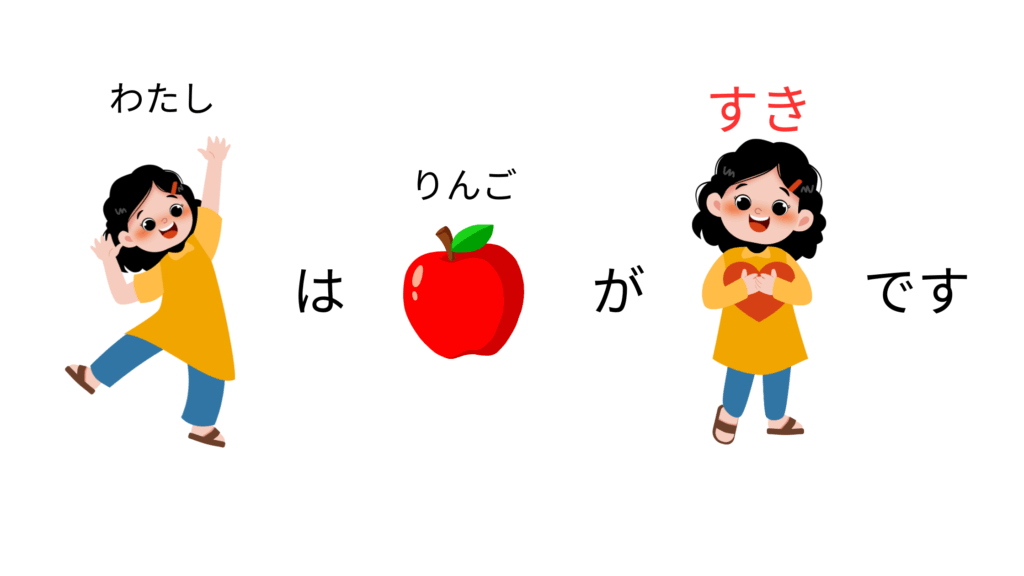Welcome to Day 21 of Your 100-Day Japanese Challenge!
おめでとう (congratulations)! You’ve made it to Day 21 of our 100-day journey to master JLPT N5!
By now, you’ve tackled hiragana, greetings, numbers, family introductions, and even basic nouns. You’re building a solid foundation to learn Japanese for beginners, and today, we’re adding a fun, everyday skill: talking about what you like using the word すき (suki).
Whether it’s anime, sushi, or soccer, this lesson will help you express your passions in Japanese.
Imagine chatting with a Japanese friend about your favorite hobbies – that’s where we’re heading! Let’s dive in and make this a fun step toward JLPT N5 prep.
Why すき (Suki) Matters for Beginners
The word すき (suki) means “like” or “love” and is a cornerstone of JLPT N5 vocabulary.
It’s versatile, used in casual conversations to share preferences about food, activities, or even people. In the JLPT N5 exam, you’ll see すき in reading and listening sections, often paired with nouns and the particle が (ga).
Mastering すき today will help you form natural sentences like わたし は すし が すき です (watashi wa sushi ga suki desu – I like sushi).
Plus, it’s a great way to connect with others by sharing what makes you happy!
Cultural note: Japanese people often use すき to express mild affection or preference, while あい (ai, love) is reserved for deeper emotions.
So, saying すき is polite and safe in most settings – perfect for beginners!
Main Lesson: How to Use すき (Suki) Step-by-Step
Let’s break down how to use すき to talk about your likes. This lesson builds on your knowledge of nouns (from Day 20) and the particle は (from Day 15).
We’ll also introduce the particle が, which pairs with すき to mark the thing you like.
Step 1: Understanding すき as an Adjective
- すき is a na-adjective, meaning it describes something (e.g., “I like X”).
- It’s often used in the structure: [Person] は [Thing] が すき です.
- は marks the person (the topic, like “I” or “you”).
- が highlights the thing you like.
- です makes it polite, perfect for JLPT N5.
Example:
- わたし は りんご が すき です。
(Watashi wa ringo ga suki desu.)
I like apples.

Step 2: The Particle が
が emphasizes the object of your affection. Think of it as pointing at what you like.
Compare:
- は (topic marker): わたし は すし が すき です (As for me, I like sushi).
- が (object marker): すし が すき です (Sushi is what I like).
Step 3: Vocabulary for Likes
Here’s a table of JLPT N5 nouns to use with すき. Practice these to build sentences!
| Hiragana | Romaji | English |
|---|---|---|
| すし | sushi | Sushi |
| りんご | ringo | Apple |
| みず | mizu | Water |
| ねこ | neko | Cat |
| いぬ | inu | Dog |
| ほん | hon | Book |
| えいが | eiga | Movie |
| おんがく | ongaku | Music |
Step 4: Forming Sentences
Let’s put it together. Use this structure:
[Your name/わたし] は [noun] が すき です.
Examples:
- わたし は ねこ が すき です。 (Watashi wa neko ga suki desu.) I like cats.
- たなか さん は おんがく が すき です。 (Tanaka-san wa ongaku ga suki desu.) Tanaka likes music.
- あなた は えいが が すき です か? (Anata wa eiga ga suki desu ka?) Do you like movies?
Notice the question form!
Adding か at the end turns it into a question – super useful for conversations.
Step 5: Negative Form
To say you don’t like something, use すき じゃ ありません (suki ja arimasen).
- わたし は すし が すき じゃ ありません。
(Watashi wa sushi ga suki ja arimasen.)
I don’t like sushi.
Practice: Let’s Talk About Your Likes!
Ready to practice? These interactive exercises will help you use すき like a pro. Grab a notebook or try these on your phone!
Day 21 Quiz: Talking About Likes with すき
1. わたし は ____ が すき です。 (I like apples.)
2. Translate to Japanese: “You like movies.”
3. たなか さん は おんがく が すき ____? (Does Tanaka like music?)
4. Translate to English: やまだ さん は いぬ が すき じゃ ありません。
5. すずき さん は ____ が すき です。 (Suzuki likes books.)
6. Translate to Japanese: “I don’t like water.”
7. あなた は ねこ が すき ____? (Do you like cats?)
8. Translate to English: さとう さん は りんご が すき です。
9. わたし は ____ が すき じゃ ありません。 (I don’t like music.)
10. Translate to Japanese: “Does Yamada like books?”
Common Mistakes for English Speakers
English speakers often stumble with すき. Here’s how to avoid pitfalls:
- Mixing は and が: Use は for the person (わたし は) and が for the thing you like (すし が). Don’t say わたし が すし が すき – it’s confusing!
- Pronunciation: すき is “sue-kee,” not “soo-kee.”
- Overusing すき: For stronger emotions, Japanese speakers might use だいすき (daisuki – really like/love). Save this for later lessons!
Conclusion: You’re One Step Closer to JLPT N5!
Today, you learned to express likes with すき, mastered the particle が, and practiced forming sentences.
You’re now ready to share your passions in Japanese – how cool is that?
Keep up this momentum, and by Day 100, you’ll be acing JLPT N5 prep!
Tomorrow, join us for Day 22: Asking Questions with 何 (Nani) – What’s That? to learn how to ask about things around you.
Love this lesson? Subscribe to our newsletter for daily tips and exclusive resources to supercharge your Japanese learning. Share this article with a friend and challenge them to write a すき sentence in the comments! じゃあ、また あした! (See you tomorrow!)



